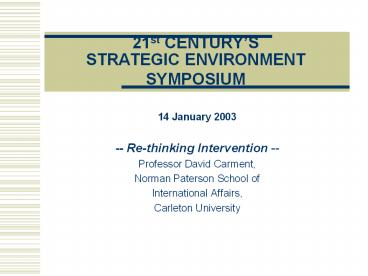21st CENTURY - PowerPoint PPT Presentation
Title:
21st CENTURY
Description:
The number and magnitude of armed conflicts within and among states has ... the use of force for self defense only, the interposition of troops after ... – PowerPoint PPT presentation
Number of Views:61
Avg rating:3.0/5.0
Title: 21st CENTURY
1
21st CENTURYS STRATEGIC ENVIRONMENT SYMPOSIUM
- 14 January 2003
- -- Re-thinking Intervention --
- Professor David Carment,
- Norman Paterson School of
- International Affairs,
- Carleton University
2
Three Positive Trends
- The number and magnitude of armed conflicts
within and among states has significantly
decreased since the early 1990s and the world is
a less riskier place to live than it was five or
even ten years ago. Three positive trends have
been identified - 1) ethnic groups are gaining even greater
autonomy and power sharing and - 2) democratic governments now outnumber
autocratic governments two to one - 3) and continue to be more successful in
resolving violent societal conflicts
3
Current Environment
- Fundamental system-wide problem of state failure
as a structural and global problem that is
unlikely to go away in the short run - Many states in the developing world have failed,
are failing or will fail in the next 20-30 years - Most are in sub-Sahara Africa
4
Track Record
- The failure to prevent the slow collapse of
states in Central and West Africa despite clear
understanding of when and where such events would
occur and the availability of forecasts for
predicting and explaining their causes and
manifestations (Congo, Guinea, Sierra Leone) - The failure to anticipate the moral hazards that
are generated by efforts to address refugee
flows, ethnic cleansing and clan warfare (Rwanda,
Somalia) - The failure to understand how biased
interventions can accelerate conflict between
combatants (Kosovo, Sierra Leone, Liberia) - The failure to produce credible responses to
warring factions thereby generating even greater
violence (Rwanda, Bosnia)
5
State of Peacekeeping
- Post-Cold War peace operations differ from their
predecessor missions in a number of important
ways - the central characteristics of traditional
peacekeeping missions - the use of force for self
defense only, the interposition of troops after a
ceasefire and the maintenance of tactical and
strategic impartiality - no longer provide the
boundaries for presumed mission success. - intrastate conflicts are more complex and more
deadly for both peacekeepers and ordinary
citizens caught in the fray. - In order to perform functions such as
guaranteeing the safe passage of humanitarian aid
and assisting and protecting displaced persons,
peacekeepers have had to resort to more forceful
actions.
6
Policy Insights
- Several initiatives have been undertaken to
advance the debate on collective security and
peacekeeping. These include the Report of the
Panel on United Nations Peace Operations (the
Brahimi Report) which builds on the Secretary
Generals Millennium Report and the recently
launched International Commission on Intervention
and State Sovereignty (ICISS).
7
Key Recommendations
- UN as a secondary actor
- Importance of regional context
- Identification of thresholds
- Prior Risk Assessment
- Emphasis on Preventive action
8
Strategic Insights
- The assumption that interveners must be perceived
and act as impartial is now seriously questioned.
- Faced with extreme instances of political
violence, a coalition of states or an
organization should not be discredited in seeing
a conflict reach a specific outcome. - The use of force must be tightly linked to the
mediation process. - Force and the threat to use force are the
coercive side of negotiating a peace plan in
which the fear of even greater costs, motivates
combatants to make concessions at the bargaining
table.
9
Strategic Insights
- Credibility and resolve relate directly to
developing effective and dynamic strategies as
well as to generating an effective reputation for
credible response over time. - Security institutions and organizations are not
just things that evolve structurally. Their
reputations and credibility also change over
time. - Any strategy that is weak in capability will not
be taken seriously as a credible deterrent and
is more likely to fail under extreme and hostile
conditions. - Peacekeeping forces must be prepared to implement
robust mandates when necessary acquiesce and
possibly withdraw in the face of stronger
counter-forces in other instances and if
incapable of mustering the necessary resolve, be
prepared to not get involved in the first place.
10
Implications for UN Peacekeeping
- Lost credibility over the last 10 years
- Secondary actor in support of regional missions
- Circumvention of the UN
- Avoid situations in which it is unlikely to
succeed
11
Implications for Intervention
- Large-scale robust missions not an automatic
guarantee of success. - A variety of operations - both large and small
that match the extensive array of belligerent
strategies are more appropriate. - We should not eliminate less intense forms of
involvement such as fact finding, observer
missions and information gathering through early
warning networks. - Information gathering is particularly crucial
in determining belligerent intentions and
strategies. - Astute leaders aware that overt tensions may lead
to escalation will prefer a low intensity war,
effective enough to accomplish specific
objectives, without attracting outside
involvement.
12
Strategic Issues
- Moral hazard actions taken to forestall violence
may encourage it - Security provided by peacekeepers and
humanitarian agencies can be understood as a
public good available to belligerents and
civilians alike. - The impact of bias forceful interventions may
encourage more violence by favouring the
ascendant side
13
Summary
- Preference should be given to preventive action
- Local analysis (risk assessment and early
warning) are crucial - Costs of early intervention are less than late
intervention





![[DOWNLOAD]⚡️PDF✔️ 21st Century Coffee: A Guide PowerPoint PPT Presentation](https://s3.amazonaws.com/images.powershow.com/10136170.th0.jpg?_=202409231212)
![[DOWNLOAD]⚡️PDF✔️ 21st Century Coffee: A Guide PowerPoint PPT Presentation](https://s3.amazonaws.com/images.powershow.com/10134202.th0.jpg?_=20240920056)
![[DOWNLOAD]⚡️PDF✔️ 21st Century Coffee: A Guide PowerPoint PPT Presentation](https://s3.amazonaws.com/images.powershow.com/10132204.th0.jpg?_=20240917107)



![[PDF READ ONLINE] 21 Lessons for the 21st Century PowerPoint PPT Presentation](https://s3.amazonaws.com/images.powershow.com/10106291.th0.jpg?_=20240823111)









![[PDF⚡READ❤ONLINE] Private Security in the 21st Century: Concepts and Applications: Concepts and PowerPoint PPT Presentation](https://s3.amazonaws.com/images.powershow.com/10045179.th0.jpg?_=20240601077)









